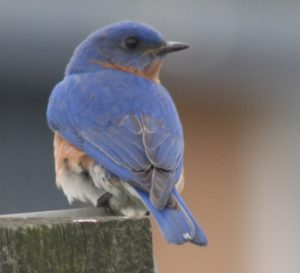(Sialia sialis )

Eastern Bluebirds are small song birds that are members of the thrush family, measuring from six to eight inches in length. They have large eyes, round heads, and slender, short bills which are wide at the base. Males have bright blue backs and heads as well as a rusty red breast. Females are the same color but much duller. The belly and feathers under the tail are white. (Click on image for more information.) They reside in Georgia year round. They breed from February through September. During breeding season, both males and females may become very aggressive. They fight over mates and nest sites. Female birds sometimes kill other female birds during these fights. Preferred nesting habitat includes open areas with few trees and forest edges. The female builds a nest of grasses or pine needles in a cavity 3-40 ft. above ground. In addition to nesting in natural cavities in oaks and pines, bluebirds readily use nest boxes.
Eastern bluebirds are commonly found in open habitats near the edge of forests. You may see them perched on a fence or on a telephone wire overhead. They need trees where they can hide from predators and open spaces where they can catch their prey. Bluebirds feed on insects, caterpillars, earthworms, and fruit. Sometimes they can even get frogs and lizards. In the fall and winter, their diets change to wild fruits and berries. During fall dogwood and viburnum berries are very important foods. Typical winter foods are the fruits of Virginia creeper, eastern red cedar, sumac, bayberry, honeysuckle, winterberry, and many other berry-producing shrubs and vines.
Eastern Bluebird numbers had been declining over the past century due to loss of habitat; competition for nesting space from house sparrows and European starlings; and predators. Snakes, hawks, raccoons, and cats are common predators of bluebirds. However, numbers are now increasing, most likely as a result of nest box campaigns and warmer winters.
Fun Facts
Bluebirds can fly at speeds up to 45 miles per hour if necessary.
Eastern and western bluebirds sit on an elevated perch while searching for insects; when one is spotted, they drop to the ground to capture it with their bill. This sit-and-wait technique is called drop-hunting.
Bluebirds consume about four grams of food per day, or about 12% of their body weight. This is equivalent to a 200 pound human eating 24 pounds of food each day.
A bluebird can spot caterpillars and insects in tall grass at the remarkable distance of over 50 yards.
Males may carry nest material to the nest, but they do not participate in the actual building. They spend much time guarding their mates during this time to prevent them from mating with other males.
Bluebirds have no blue pigments in their feathers. Instead, each feather barb has a thin layer of cells that absorb all wavelengths of color except blue. Only the blue wavelength is reflected and scattered, resulting in their blue appearance to our eyes.

